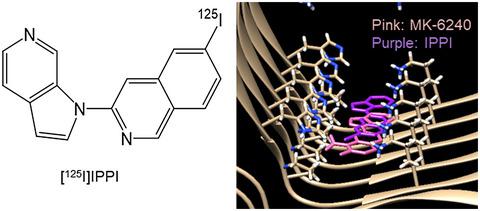Our official English website, www.x-mol.net, welcomes your
feedback! (Note: you will need to create a separate account there.)
Development and evaluation of [125 I]IPPI for Tau imaging in postmortem human Alzheimer's disease brain.
SYNAPSE ( IF 1.6 ) Pub Date : 2020-07-28 , DOI: 10.1002/syn.22183 Jogeshwar Mukherjee 1 , Christopher Liang 1 , Krystal K Patel 1 , Phuc Q Lam 1 , Rommani Mondal 1
SYNAPSE ( IF 1.6 ) Pub Date : 2020-07-28 , DOI: 10.1002/syn.22183 Jogeshwar Mukherjee 1 , Christopher Liang 1 , Krystal K Patel 1 , Phuc Q Lam 1 , Rommani Mondal 1
Affiliation

|
Objective: Alzheimer's disease (AD) is a neurodegenerative disease characterized by aggregation of Tau protein into paired helical filaments causing neurofibrillary tangles (NFT) in the brain. The aim of this study was to develop and evaluate the effectiveness of a novel radioiodinated tracer, 6‐[125I]iodo‐3‐(1H‐pyrrolo[2,3‐c]pyridine‐1‐yl)isoquinoline ([125I]IPPI), for binding to Tau protein (Ki = 0.75 nM) in postmortem human brain (AD and cognitively normal (CN). Methods: Radiosynthesis of [125I]IPPI was carried out by radioiododestannylation and purified chromatographically. Computational modeling studies of IPPI and MK‐6240 binding on Tau fibril were evaluated. In vitro autoradiography studies were carried out with [3H]PIB for Aβ plaques and [125I]IPPI for Tau in AD and CN brains and evaluate drug effects. Results: [125I]IPPI was produced in >95% purity. Molecular modeling of IPPI revealed binding energies of IPPI (−7.8, −8.1, −8.2, −7.5 Kcal/mol) at the four sites were comparable to MK‐6240 (−8.7, −8.5, −8.3, −7.5 Kcal/mol). Ratio of average grey matter (GM) [125I]IPPI in AD versus CN was found to be 7.31 (p = .07) and AD GM/ white matter (WM) = 4.35 (p = .09). Ratio of average GM/WM [125I]IPPI in CN was 1.21. Binding of [125I]IPPI correlated with the presence of Tau, confirmed by anti‐Tau Dako A0024. Specifically bound [125I]IPPI to Tau in AD brains was displaced by MK‐6240 and IPPI (>90%). Monoamine oxidase inhibitors (MAO) inhibitors deprenyl and clorgyline effected [125I]IPPI binding at >1 µM concentrations. Conclusion: [125I]IPPI exhibited high binding in human AD frontal cortex and anterior cingulate and is a suitable radioiodinated ligand for Tau imaging.
中文翻译:

[125 I]IPPI 用于死后人类阿尔茨海默病脑中 Tau 成像的开发和评估。
目的:阿尔茨海默病 (AD) 是一种神经退行性疾病,其特征是 Tau 蛋白聚集成成对的螺旋丝,导致大脑中的神经原纤维缠结 (NFT)。本研究的目的是开发和评估一种新型放射性碘示踪剂 6-[ 125 I]iodo-3-(1H-吡咯并[2,3-c]pyridine-1-yl)isoquinoline ([ 125 I] ]IPPI),用于与死后人脑(AD 和认知正常 (CN) 中的 Tau 蛋白(Ki = 0.75 nM)结合。方法:[ 125 I]IPPI 的放射合成通过放射性碘脱烷基化和色谱纯化进行。计算建模研究评估了 IPPI 和 MK-6240 对 Tau 原纤维的结合。体外放射自显影研究使用 [ 3Aβ 斑块的 H]PIB 和AD 和 CN 脑中 Tau 的[ 125 I]IPPI 并评估药物作用。结果: [ 125 I]IPPI 以>95% 的纯度生产。IPPI 的分子模型显示 IPPI 在四个位点的结合能 (-7.8, -8.1, -8.2, -7.5 Kcal/mol) 与 MK-6240 (-8.7, -8.5, -8.3, -7.5 Kcal/mol) 相当)。发现 AD 与 CN中平均灰质 (GM) [ 125 I] IPPI 的比率为 7.31 ( p = .07) 并且 AD GM/ 白质 (WM) = 4.35 ( p = .09)。CN中平均GM/WM[ 125 I]IPPI的比率为1.21。[ 125 I]IPPI 的结合与 Tau 的存在相关,由抗 Tau Dako A0024 证实。具体绑定 [ 125AD 大脑中 I]IPPI 到 Tau 被 MK-6240 和 IPPI (>90%) 取代。单胺氧化酶抑制剂 (MAO) 抑制剂 deprenyl 和 clorgyline在 >1 µM 浓度下影响 [ 125 I]IPPI 结合。结论:[ 125 I]IPPI 在人 AD 额叶皮层和前扣带回中表现出高结合力,是一种适合 Tau 成像的放射性碘化配体。
更新日期:2020-07-28
中文翻译:

[125 I]IPPI 用于死后人类阿尔茨海默病脑中 Tau 成像的开发和评估。
目的:阿尔茨海默病 (AD) 是一种神经退行性疾病,其特征是 Tau 蛋白聚集成成对的螺旋丝,导致大脑中的神经原纤维缠结 (NFT)。本研究的目的是开发和评估一种新型放射性碘示踪剂 6-[ 125 I]iodo-3-(1H-吡咯并[2,3-c]pyridine-1-yl)isoquinoline ([ 125 I] ]IPPI),用于与死后人脑(AD 和认知正常 (CN) 中的 Tau 蛋白(Ki = 0.75 nM)结合。方法:[ 125 I]IPPI 的放射合成通过放射性碘脱烷基化和色谱纯化进行。计算建模研究评估了 IPPI 和 MK-6240 对 Tau 原纤维的结合。体外放射自显影研究使用 [ 3Aβ 斑块的 H]PIB 和AD 和 CN 脑中 Tau 的[ 125 I]IPPI 并评估药物作用。结果: [ 125 I]IPPI 以>95% 的纯度生产。IPPI 的分子模型显示 IPPI 在四个位点的结合能 (-7.8, -8.1, -8.2, -7.5 Kcal/mol) 与 MK-6240 (-8.7, -8.5, -8.3, -7.5 Kcal/mol) 相当)。发现 AD 与 CN中平均灰质 (GM) [ 125 I] IPPI 的比率为 7.31 ( p = .07) 并且 AD GM/ 白质 (WM) = 4.35 ( p = .09)。CN中平均GM/WM[ 125 I]IPPI的比率为1.21。[ 125 I]IPPI 的结合与 Tau 的存在相关,由抗 Tau Dako A0024 证实。具体绑定 [ 125AD 大脑中 I]IPPI 到 Tau 被 MK-6240 和 IPPI (>90%) 取代。单胺氧化酶抑制剂 (MAO) 抑制剂 deprenyl 和 clorgyline在 >1 µM 浓度下影响 [ 125 I]IPPI 结合。结论:[ 125 I]IPPI 在人 AD 额叶皮层和前扣带回中表现出高结合力,是一种适合 Tau 成像的放射性碘化配体。









































 京公网安备 11010802027423号
京公网安备 11010802027423号